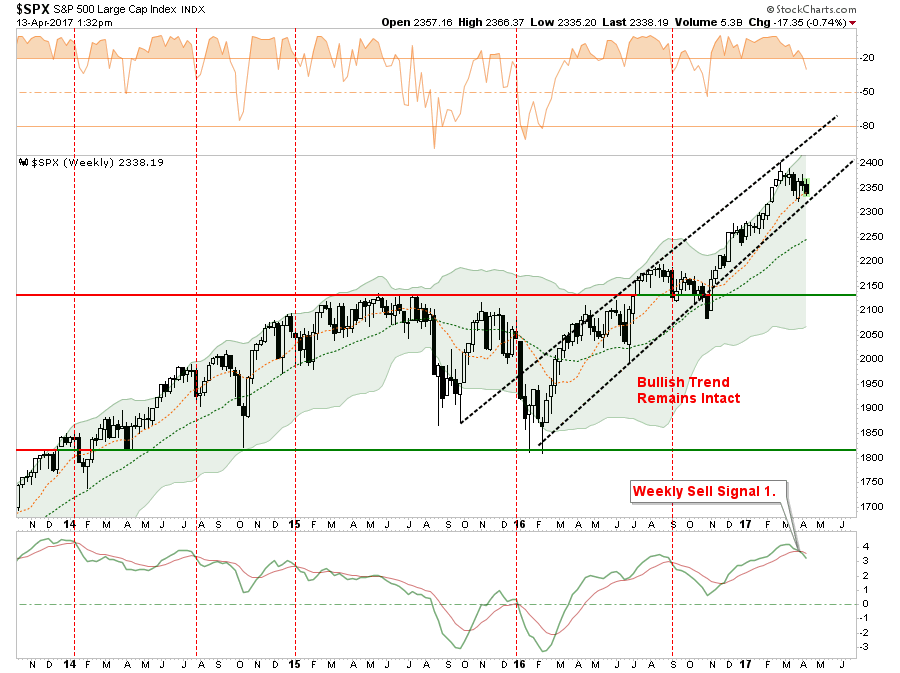Let me start with what I wrote on Friday:
“In my money management process, portfolio ‘risk’ is ‘ratcheted’ up and down based on a series of signals which tend to indicate when market dynamics are either more, or less, favorable for having capital exposed to the market.”

As you will notice, portfolios NEVER reach 100% cash levels. The reason is purely for psychological reasons.
Let me explain.
Back in 2008, we had gone to almost all cash in portfolios between April and June. I thought it would be a relatively simple process of reallocating portfolios once the right opportunity came along. I learned that was not to be the case due to the psychological trauma caused by a major bear market.
This realization came in February 2009 when I wrote the article “8-Reasons For A Bull Market” which stated:
“Any weakness next week will most likely warrant a push down to 800 for first support and then the November lows of 750. We believe that these lows will hold although we are aware that if the market doesn’t get ‘it’ together soon further weakness could show itself.
We are cautious here and still holding on to a lot of cash waiting for some signal that the market is making a turn for the short term to the better. March, April, and May tend to be fairly strong months for the market and any ‘real’ assistance next week for homeowners could push the markets higher. A move above 900 will be a signal for a move higher in the markets.“
Of course, the market bottomed on March 9th at 666 and never looked back as an estimated $33 Trillion in various bailouts, workouts, subsidies, and QE followed as shown in the table below. (This does not include the ongoing reinvestment from the Fed’s balance sheet)

Of course, the problem is that despite the massive interventions since the financial crisis, there has been very little relative return on those investments.

But I digress.
When the markets bounced above 900, suggesting it was time to re-enter the market, I faced extremely tough resistance from clients. In fact, I lost clients because they were afraid the markets would only continue lower.
While this moment was the epitome of Baron Rothschild’s statement, “The time to buy is when there’s blood in the streets,” the psychological damage was so deep, that investors could not make the switch from “absolute safety” to some “risk.”
Of course, this psychological problem is the reason why investors consistently “buy high” and “sell low.” It is also why I learned it is far easier add to an existing allocation, which can be completely hedged,as improvement is already understood.
So, why do I bring this up?
Because the market has now tripped the first signal as shown above, and below, sending a warning that further weakness could ensue. With the first signal registered, combined with a break of the 50-dma, we are now on “a signal-1 alert.”

With portfolios already hedged, as we added a lot of bond and interest rate sensitive holdings back in January, there is no action to take currently. This is why, for now, it is only an “alert” that something more important is developing.
The bullish trend remains intact, and the two primary signals (2 & 3), which would initiate further equity reductions, remain on “buy signals” currently.
But this signal should be of no surprise to readers as we have been watching the development over the last few weeks. As I noted last week in “Questioning The Bullish Trend:”
“As stated, portfolios remain bullishly allocated for now but with a cautious underpinning.We are still maintaining hedges until the current corrective action completes.
Furthermore, we are currently maintaining “new money” in short-term cash positions and only selectively stepping into core long-term holdings with tight stop-loss levels.”
Such remains the case this coming week.
IMPORTANT: By the time weekly signals are issued on an intermediate-term basis, the market is generally oversold, with “bearish” sentiment increasing, on a short-term (daily) basis. Given those short-term conditions, it is quite likely the markets will rally next week.

IMPORTANT: It is the success or failure of that rally attempt that will dictate what happens next.














Leave A Comment